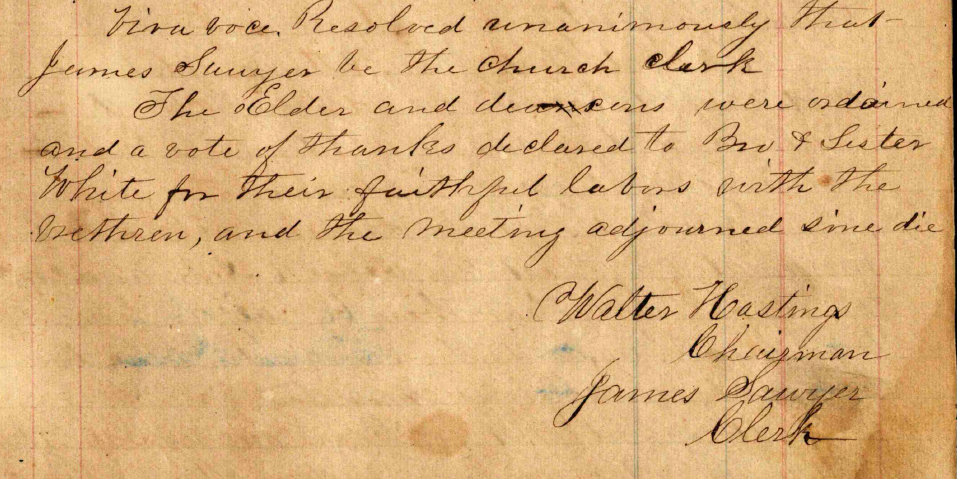
A page in the Wright Church Record Book, 1861-1877, where the Wright Church was founded on December 17, 1861. It shows James Sawyer’s name twice (voted as church clerk, and signed as clerk) and also a vote to thank "Bro. and Sister White for their faithful labors with the brethren." [PC: Courtesy of Center for Adventist Research, Berrien Springs, Mich]
James hailed from Coopersville, Michigan. In the winter of 1858, he traveled six miles to the small town of Wright to attend a series of Adventist lectures by Joseph Birchard Frisbie. The messages stirred his heart, and by March of that year, his name appeared in the Review and Herald as a believer in “present truth.”
Not long afterward, in late 1859, James married 19-year-old Ansta Lester from Illinois. James worked as a schoolteacher and later as a surveyor, but his heart remained close to the church. In December 1861, he became a founding member of the Wright Seventh-day Adventist Church and served as its first clerk for nearly a decade.
James and Ansta’s journey was not without challenges. In the spring of 1863, Ellen G. White wrote a testimony addressed to both of them. She warned James against promoting speculative interpretations of Scripture that were out of harmony with the wider church. Ansta, though committed in some ways, was still growing spiritually. Ellen White gently but firmly counseled her to lay aside frivolous behavior and assume greater responsibility in her home and faith. “God help you both,” Ellen wrote, “to be united to serve and glorify God” (Lt 8, 1863).
James responded with humility. In the June 9, 1863, Review, he publicly expressed a renewed desire to live wholly for God and rejoiced that Ansta had taken “a decided stand for the Lord.” Although church records do not mention when Ansta was baptized, James’s statement points to a hopeful transformation.
James’s vision extended beyond his local congregation. In 1873, he encouraged church leaders in Battle Creek to create a publication for Scandinavian immigrants. Motivated by his love for these communities, James even learned Swedish himself. His efforts helped launch Svensk Advent Härold in 1874—the first Swedish-language Adventist periodical in the United States. Later, he served as a city missionary in Chicago until his death in 1886.
Ansta also served the church in her own right, working for many years at the Review and Herald office. Her behind-the-scenes contributions, alongside James’s leadership and outreach, made them a team that—despite early struggles—left a meaningful imprint on Adventist history.
Their story reminds us that spiritual growth is often a journey, not a moment. James and Ansta experienced correction, change, and ultimately a deeper commitment to their calling. Their willingness to grow—and to serve beyond themselves—continues to inspire.
![A page in the Wright Church Record Book, 1861-1877, where the Wright Church was founded on December 17, 1861. It shows James Sawyer’s name twice (voted as church clerk, and signed as clerk) and also a vote to thank "Bro. and Sister White for their faithful labors with the brethren." [PC: Courtesy of Center for Adventist Research, Berrien Springs, Mich]](/build/image/14889.png?or=360&crop=%2C%2C%2C&w=480&h=480&s=bc022319d18c0ba10cecfed1d891d214)
Denis Kaiser is an associate professor of church history at the Seventh-day Adventist Theological Seminary at Andrews University.